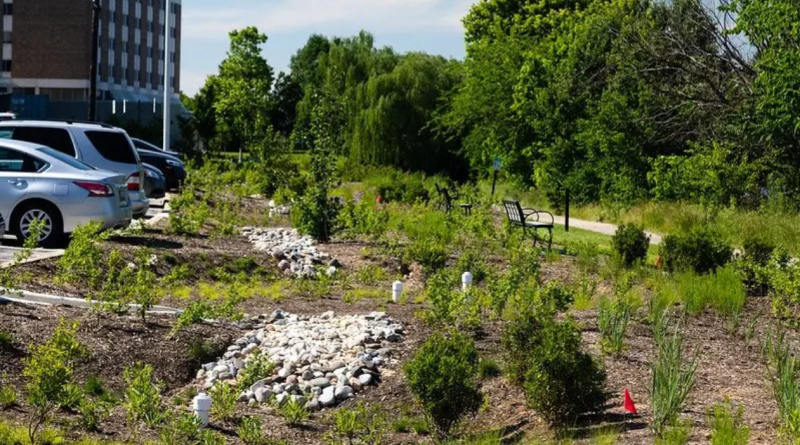Cool, Green Infrastructure Can Beat Urban Heat and Drought, Experts Say

Reflective and green infrastructure is now essential to combat the extreme heat and drought in the cards for hundreds of millions of urban dwellers as the planet continues to warm, says the World Resources Institute (WRI).
Cities in developing countries are at particular risk, with their marginalized communities even more exposed, the institute writes in a recent explainer.
Shifting a city’s “land cover components” from heat-absorbing surfaces like asphalt to the cooling green of trees and shrubs, as well as reflective surfaces, can “dramatically lower” its temperature. For instance in Mumbai, a healthy share of vegetation cover made one neighbourhood as much as 5.5°C cooler than those that were bereft of green spaces, WRI says, citing its recent analysis of the relationship between land cover and heat.
Expanding a green umbrella of cooling throughout the city is particularly urgent in a city where 37% of households, in low-income neighbourhoods and informal settlements, live in homes with metal roofs, leaving them cooking in the summer heat.
Cities Embrace ‘Cool Infrastructure’
Whether natural or built, “cool infrastructure” alone can reduce the urban heat island effect in cities by as much as 4°C, WRI writes. Vegetation, particularly trees, helps cool the air through the heat-absorbing process of evapotranspiration. Trees further benefit residents by providing life-protecting shade.
The cooling benefits of planting trees in cities are clear in Medellín, Colombia. Three years after planting 8,000 trees “to create an interconnected network of green spaces across the city to address heat while improving access to nature and improving biodiversity,” city officials estimate the urban heat island effect has decreased by 2°C.
Cool infrastructure can also be the work of human hands. WRI cites the collective efforts by a group of women living in the slums of Ahmedabad, India, to make their communities more climate resilient. As part of their low-cost efforts, the Women’s Action Towards Climate Resilience for the Urban Poor painted the roofs of 17,000 homes white, helping to reflect heat back into the atmosphere.
Cool infrastructure offers immediate health benefits and lowers energy consumption, contributing to long-term climate goals, WRI says. It also enhances productivity, promotes better mental health, and increases public access to green spaces.
From Data to Action
“Cool infrastructure solutions have been piloted in hundreds of cities around the world, but there are thousands of cities that can and should adopt these tactics at large scale,” writes WRI. A dearth of data remains an obstacle to scaling cool solutions.
The Smart Surfaces Coalition, Arsht-Rockefeller Resilience Center, Cool Cities Network, as well as WRI projects like Cities4Forests, are entities and initiatives trying to close this gap.
“The hope is that new data used to power analytical tools that meet the needs of decision-makers can accelerate the adoption of and funding for cool infrastructure to help residents adapt to more extreme heat while bringing emissions down in time to avert even hotter temperatures,” writes WRI.
Keeping the Taps Running
Early April saw Bogotá, Colombia, rationing water to help its more than 11 million residents cope with an unprecedented depletion in the Chingaza reservoir that supplies the capital with 70% of its water.
“Rationing measures will likely remain in place through October 2024, or until there is enough rainfall to course correct,” writes WRI in a report published earlier in June.
Bogotá is hardly alone in its growing thirst. Johannesburg, Mexico City, and the island of Sicily are just a few of the many places on Earth growing ever more parched as the planet warms, as drought exacerbates longer-standing problems of over-extraction and crumbling infrastructure.
As with extreme heat, nature-based solutions stand ready to help—quite literally in the form of restored, protected, and expanded forest ecosystems within and around cities.
Protecting the forests ecosystems that support the watersheds upon which cities depend will improve water quality and quantity cost-effectively, while making the watersheds themselves more climate resilient.
The water-protecting powers of forests are rooted in the water cycle itself, as they support both the steady evaporation of water from soil and water surfaces, and from plant tissues (in a process known as transpiration) into the atmosphere. Such steady support “allows for a more regular water cycle and, therefore, more regular rain to recharge groundwater and fill watersheds,” writes WRI.
Forests are also purpose-built filtration systems, with leaves and roots acting to slow down the rate at which water enters the soil and thereby supporting “a more reliable and consistent groundwater recharge.”
Having water percolate through the soil also helps prevent erosion, with forest roots adding to the protective effect. “Both features reduce erosion, preventing debris from entering watersheds and reducing the need for water treatment and/or reservoir dredging,” writes WRI.
Cleaner and clearer water from the get-go will yield serious economic benefits, the institute adds. “In Bogotá, for example, the water utility could save approximately $45 million over 30 years by investing $5.3 million upfront in nature-based solutions such as ecosystem restoration.”






